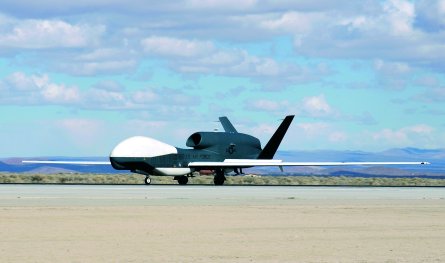NATO’s premier aerospace capability think-tank, the Joint Air Power Competency Centre, is calling for the near-term acquisition of a fleet of high- and medium-altitude long-endurance unmanned air vehicles by the alliance to overcome ongoing capability shortfalls that will only be partially filled by the existing Alliance Ground Surveillance project.
The JAPCC says that while NATO has current requirements for access to 50 HALE-class and 20 MALE-class systems, existing and planned member nation capabilities do not support alliance operational needs.
The proposed acquisitions would also support requirements for a fully integrated unmanned air systems architecture across the alliance, according to the JAPCC’s draft “Flight plan for UAS in NATO”.
Released on 18 October at the JAPCC’s annual air power conference in Kleve, Germany, the draft warns that there are few mechanisms in place allowing for seamless operation and co-ordination of UAVs between member nations.

It says that NATO needs to urgently establish a single overarching co-ordination body to handle all unmanned air systems issues, with this encompassing all existing NATO UAV-related working groups, including the Joint Capability Group on UAVs set up last year. The new overarching body should be in place by the end of 2007, it argues, followed by the completion of alliance concepts of operations for UAVs by early 2008.
This would allow for more effective roll-out of unmanned air systems capabilities across the alliance, the draft document argues. “What is still needed and desired is that there be a body in NATO that brings together all the needed people to ensure all the parts are there for unmanned air system operations…There is an urgent need for someone to look at the complete picture of doctrine, organisation, training, materiel, leadership, personnel and facilities,” it says.
The new body could be set up under the auspices of Allied Command Transformation or the proposed NATO joint air power committee the draft plan says.
Gen Lance Smith, supreme allied commander transformation, says: “I think the imperative to co-ordinate efforts is an obvious one and a board or a body seems to me logical. How that would float in actual operations and where that would occur in actual operations still has to be explored.”
Smith told media attending the conference that “there are existing collection management boards, there are existing airspace control authorities and the like that are out there that also would have to have a play in this”.
He said: “The problems here are not about technological development, it is about co-ordination and collaboration and interoperability.”
The draft flight plan warns that effective UAV availability for NATO operations “is not consistent and often non-existent”. It says that during “recent Balkan operations NATO had to lease manned reconnaissance capability because no UAS were available”.
Existing NATO staff requirements for MALE and HALE UAVs, endorsed at the 2002 Prague Summit, need to result in an acquisition by the end of 2009 it argues. However, funding and capability commitments are still to be secured among member nations. There needs to be a push from NATO planning bodies during 2007 to drive the requirements forward it argues.
The USA remains the only member nation with operational HALE capabilities, but has limited asset availability, meaning NATO access is not assured, says the draft document. Other NATO members are progressively acquiring MALE systems in numbers that may meet alliance requirements, however “what will be most important is for the assets to be assigned to NATO when required”.
The commander of US Air Forces in Europe and JAPPC director Gen William Hobbins told the Kleve conference that the introduction of the AGS system into NATO service from 2012 will play a key role in shaping how the alliance co-ordinates its endurance UAV capabilities at an operational level. He said the system, comprising four Airbus A320 manned aircraft and four Northrop Grumman RQ-4B Block 20 Global Hawk UAVs, “represents the first ever integrated manned-unmanned aircraft system”.
He described the project as propelling “NATO straight into the unmanned realm, and is leading the way with this first-ever type of system. As NATO transforms itself so that it can meet the needs of tomorrow, what NATO needs is to handle unmanned aircraft just as if they were manned. We need for unmanned aircraft to act like manned aircraft. We need unmanned aircraft to be tasked like manned aircraft. We need unmanned aircraft to be able to fly in strike packages with manned aircraft.”
A final version of the flight plan is expected to issued late this year for consideration by Alliance Command Transformation during early 2007.
JAPCC executive director Lt Gen Hans-Joachim Schubert says the draft is intended to push planning decisions within NATO on how best to co-ordinate UAV capabilities across the alliance: “This process is now initiated.”
The draft flight plan says surveillance, reconnaissance and target acquisition roles will dominate NATO requirements for the foreseeable future. However, this is likely to rapidly expand to include missions such as persistent overwatch; signals intelligence; nuclear, chemical and biological weapons detection and tracking; communications relay; combat search and rescue; and tactical aerial delivery and resupply. New civil support missions are likely to include mine detection, psychological operations, and possibly pipeline monitoring.
The draft reveals that NATO planners are working on a staff requirements document for tactical UAVs, with this to include guidance on the numbers of aircraft required.
It also says weaponisation of NATO UAVs is possible, although as a longer- term option: “The first UAV combat roles are likely to be close air support and air to air combat, but it will be many years before NATO has doctrine and procedures to implement these combat capabilities.”
Source: FlightGlobal.com























